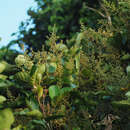en
names in breadcrumbs


Aglaia rimosa is an evergreen small tree[3] in the family Meliaceae.[4] It is found in Indonesia, Papua New Guinea, the Philippines, and Taiwan (Hengchun Peninsula and Orchid Island[5] ). Aglaia rimosa "grows primarily in the wet tropical biome".[6]The official name of Aglaia rimosa in Taiwan is Large-leaved aglaia, because compared with the other two species native to Taiwan, Aglaia elaeagnoidea and Aglaias chittagonga, the leaflet of Aglaia rimosa is larger than their leaflet, all three are imparipinnate.[7]The flowers of Aglaia rimosa have fragrance, but it is lighter than that of Aglaia odorata.[8]The anticancer compound Rocaglamide (RocA) was originally extracted from Aglaia rimosa by researchers in Taiwan.[9]
Aglaia rimosa is an evergreen small tree in the family Meliaceae. It is found in Indonesia, Papua New Guinea, the Philippines, and Taiwan (Hengchun Peninsula and Orchid Island ). Aglaia rimosa "grows primarily in the wet tropical biome".The official name of Aglaia rimosa in Taiwan is Large-leaved aglaia, because compared with the other two species native to Taiwan, Aglaia elaeagnoidea and Aglaias chittagonga, the leaflet of Aglaia rimosa is larger than their leaflet, all three are imparipinnate.The flowers of Aglaia rimosa have fragrance, but it is lighter than that of Aglaia odorata.The anticancer compound Rocaglamide (RocA) was originally extracted from Aglaia rimosa by researchers in Taiwan.